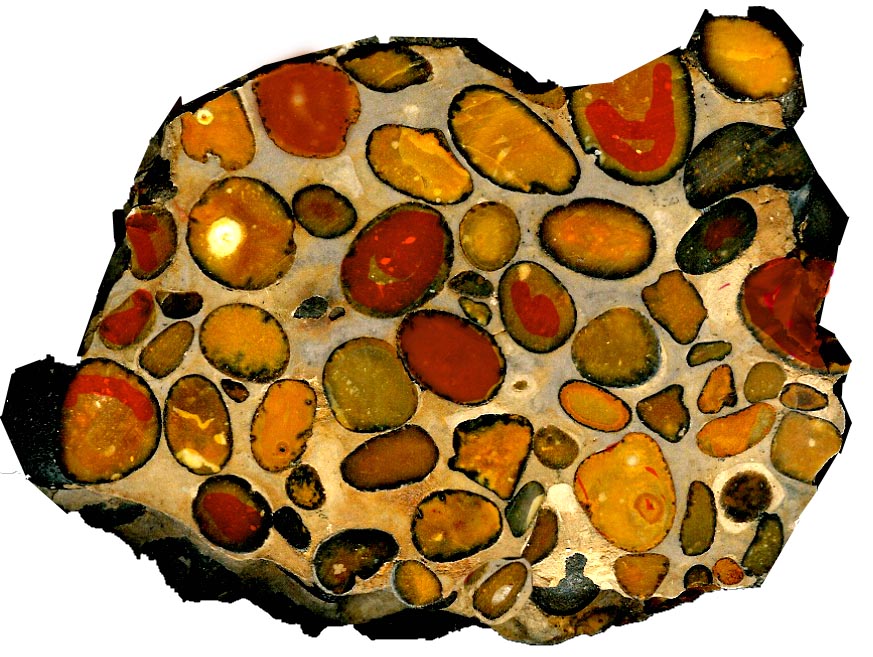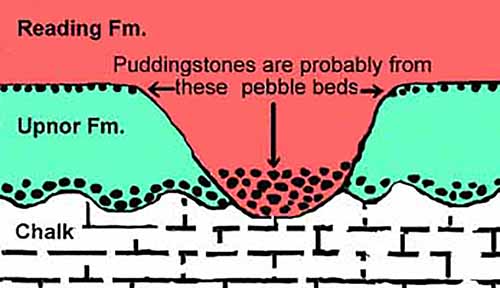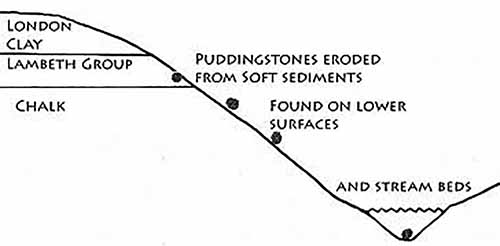Puddingstone formation
A pdf version of this page can be downloaded here.
Hertfordshire Puddingstone is a conglomerate of rounded flint pebbles in a matrix of fine pale sand all cemented together (basically a ‘fossil beach’). As the pebbles, the sand and the cementing material are all silica the rock is very hard and breaks evenly across pebbles and sandy matrix.
Despite its name, Hertfordshire Puddingstone isn’t exclusive to our county, it is found elsewhere in south east England and in Northern France, but we have a lot of it, including handsome pieces with coloured pebbles.
The story of Hertfordshire Puddingstone is also the story of climate changes over the last 80 million years ranging between extremes of hot and cold.


Point 1. About 80 million years ago in the Cretaceous, global temperatures and sea levels were very high, a time known as the ‘Cretaceous greenhouse’. Much of the Earth’s surface, including most of the British Isles was under a warm clear sea, on the floor of which chalk was deposited. Later flint formed chemically within the chalk.
Point 2. About 63 Million years ago temperatures and sea levels fell, and south east England was raised above sea level by earth movements. Chalk was exposed at the surface, and being very soft and easily dissolved in rainwater some was removed by rivers.
As the chalk was removed the hard flints were left on the surface. Newly exposed flints are of various shapes and sizes, with white coats and black/grey insides.
Some flints were picked up by rivers where the flowing water bashed them into each other breaking them into angular fragments forming gravel on the river bed.

From about 60 million years ago local sea levels fluctuated, sometimes Hertfordshire was under water when sands and clays were deposited, and sometimes dry land being eroded by rivers. As sea level rose and fell the coastline passed through Hertfordshire, and, as on modern beaches gravel transported by rivers was rounded by wave action. The pebbles are very well rounded so were probably on gravel bars around lagoons.


In some places, particularly in Eastern Hertfordshire, iron compounds stained the pebbles giving them black rims and attractive colours.
The pebbles were then mixed with fine pale sand as can be seen on modern beaches.
This picture shows unstained and stained pebbles.
Point 3 Our puddingstone was probably formed in several episodes around 56-55 million years ago during times of lower sea level when the pebble/sand mix was on or near the surface. The climate was semi-arid and temperatures were higher than today, especially during a peak lasting about 100,000 years. The high temperatures caused silica to dissolve in alkaline groundwater, which was drawn up through the pebbles and sand by evaporation and, in patches, solidified to form puddingstone.
Puddingstones are elusive in situ most finds have been eroded out and deposited on slopes or valley bottoms. This makes it difficult to be certain exactly where and when they formed.
The cementing probably happened in the Lambeth Group of sediments (in East Herts the Upnor and Reading Formations), with the pebble/sand mix deposited on top of the Upnor Formation and patchily cemented in early Reading Formation times.
As sea level continued to fluctuate loose pebbles and puddingstones were covered by sediments. Clay was deposited in a delta during Reading Formation times with rivers cutting down through the Upnor Formation and in places depositing loose pebbles and puddingstones in the river beds. This was followed by sands and clays of the Harwich and London Clay Formations.


Sketches (not to scale) showing (a) the probable position of puddingstones (b) why puddingstones are seldom found in situ.
Point 4 From about 30 million years ago global temperatures began to fall, the cooling accelerated from around 5 million years ago towards the present ice age which began nearly 2 million years ago. This has been a series of cold (glacial) periods and warmer (interglacial) periods. During glacials ice advanced from the north, in most cases not reaching this far south, though temperatures would have been very cold and the ground frozen. About 1 million years ago the Thames flowed through Hertfordshire depositing river gravels. Nearly half a million years ago ice of the Anglian glaciation advanced across Hertfordshire, diverting the Thames, and scraping up sediments including puddingstones and loose sand and gravel. When temperatures rose again, huge rivers of meltwater gushed from beneath the glacier. The rivers carried sediments which had been collected by the glacier, and these were deposited as the ice retreated leaving a lot of sand and gravel in Hertfordshire.
When this is quarried blocks of puddingstone are also found, which is why it is sometimes said to be of glacial origin, as in the Standon puddingstone (see Myths page).
But the ice age wasn’t puddingstone’s origin, just another chapter in its story of changing climates.